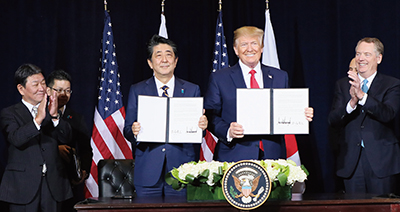Diplomatic Bluebook 2020
Chapter 3
Japan's Foreign Policy to Promote National and Global Interests
Section 3 Economic Diplomacy
1 Overview of Economic Diplomacy
As inter-state competition arises in the fields of politics, the economy, and the military, the balance of power in the international community is changing in an increasingly rapid and complex manner, while uncertainty over the existing international order is growing. Japan is tackling a range of issues, particularly in the economic sphere, that include the changing structure of the domestic and global economy, the rise of protectionism, and trade conflicts.
Amid such circumstances, Japan held the Osaka Summit in June as this year's G20 Presidency. At the Summit, Japan took leadership as the Presidency with a uniquely Japanese approach marked by a persistence in identifying common grounds and points of agreement. As a result, leaders of the major countries showed their unity to grapple with global economic issues, by reaffirming basic principles supporting the international free trade system, such as free, fair non-discriminatory and level-playing field. At the G20 Aichi-Nagoya Foreign Ministers' Meeting in November, Foreign Ministers confirmed the outcomes of the G20 Osaka Summit and made the event a springboard leading to concrete action in the future.
Japan's prosperity is based on maintaining and strengthening the free and open international economic system, which also leads to the stability and growth of the global economy. Reform of the World Trade Organization (WTO), the cornerstone of the Multilateral Trading System, is especially necessary now given the numerous challenges it currently faces, among which is the paralysis of the Appellate Body. The Japan-U.S. Trade Agreement entered into force on January 1, 2020, which, along with the Trans-Pacific Partnership (TPP11) and Japan-EU Economic Partnership Agreement, has created a free economic sphere covering 60% of the global GDP (see the Special Feature on page 265). Japan is also playing a leading role toward the early signing of the Regional Comprehensive Economic Partnership (RCEP) Agreement. In addition, Japan is aiming to promptly begin trade negotiations with the UK, which left the EU at the end of January 2020.
Japan has advanced initiatives with the aim of further accelerating the promotion of economic diplomacy as one of the priority areas of Japan's diplomacy, centered around the following three aspects: (1) rule-making to bolster free and open global economic systems by promoting the various economic agreements described above; (2) supporting the overseas business expansion of Japanese companies through promotion of public-private partnerships; and (3) promoting resource diplomacy along with inbound tourism to Japan.
Based on the Joint Statement of Japan and the U.S. issued in September 2018, Foreign Minister Motegi (Minister in charge of Economic Revitalization until September 2019) and U.S. Trade Representative Lighthizer held eight ministerial consultations for a five-month period from April 2019. Consequently, the two leaders reached a final agreement on the Japan-U.S. Trade Agreement and the Japan-U.S. Digital Trade Agreement at the Japan-U.S. Summit Meeting in September 2019, and issued the Joint Statement. The two agreements entered into force on January 1 2020. Despite the protectionism spreading across the world, Japan showed its presence in the global arena with regard to promoting free trade through the conclusion of these two agreements. This Special Feature introduces the significance and overview of the two agreements.
 Japan-U.S. Summit Meeting (September 25, 2019, New York, U.S.; Photo: Cabinet Public Relations Office)
Japan-U.S. Summit Meeting (September 25, 2019, New York, U.S.; Photo: Cabinet Public Relations Office)Japan-U.S. Trade Agreement
The Japan-U.S. Trade Agreement, which covers approximately 30% of global GDP, aims to enhance bilateral trade between Japan and the U.S. in a robust, stable, and mutually beneficial manner. This agreement, together with the Comprehensive and Progressive Agreement for Trans-Pacific Partnership (TPP11) and the Japan-EU Economic Partnership Agreement (EPA), which had already entered into force, has created a free economic sphere, covering approximately 60% of the global economy, with Japan at its center.
The agreement is mutually beneficial and well-balanced for both Japan and the U.S. Japan's agricultural products are all within the scope of previous economic partnership agreements. The Agreement is fair for the U.S. as well. Amid the TPP11 and other agreements already come into effect, the agreement realizes a situation in which the U.S. will not be subordinate to other countries. Regarding automobiles and automobile parts exported to the U.S., the U.S. annex stipulates that they will be subject to further negotiations with respect to the elimination of customs duties. Moreover, custom duties on other industrial products, especially the products of Japanese companies' interest and of large trade volume, will also be eliminated or reduced soon. At the same time, this agreement also attaches great significance in its elimination of measures that distort the global supply chain, including the quantity restrictive measures to automobiles, voluntary export restraint, and strict rules of origin; therefore, the agreement helps to enhance bilateral trade in a stable manner. The agreement contributes not only to the further growth of the Japanese economy, but also to the development of a free and fair world economy.
Japan-U.S. Digital Trade Agreement
The Japan-U.S. Digital Trade Agreement establishes high-standard rules in the digital field, and lays the foundation on which Japan and the U.S. will play a leading role in developing global rules on digital trade. The Agreement includes clauses that correspond to the latest situation in the digital field, such as the same clauses as the electronic commerce chapter of the TPP, including provisions of not only prohibiting the imposition of customs duties to digital products distributed electronically, but also of ensuring non-discriminatory treatment of digital products. The agreement also includes provisions that prohibit the requirement of disclosure of algorithms and cryptography, and of civil liability to information content providers, including social media providers.

